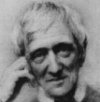
Principle 7. Growth in understanding what God wantsWe find in Sacred Scripture - and the Church - a gradual unfording of truth, in doctrine, morals and church organization.
|
Interpreting Scripture correctlyLESSON SEVEN
|
Growing up takes time
Education takes time. Many years are required to make children responsible citizens. Teachers will tell you of the remarkable change that takes place between the time when boys and girls enter the primary school and when they leave college. The process is slow and yet in the course of the years what a development can be seen from the small children that hop and skip on the playground to the grown-up housewives, physicians, managers or technicians they eventually become! Much intellectual, moral and professional training is needed to achieve this transformation. And the secret of it all is gradual instruction. Months of patient labour have to be devoted to the teaching of the A-B-C and the instilling of the first principles of duty, honesty and charity. The straight plunge into the deep does more harm than good. No child would benefit from being confronted with a textbook on Higher Science on the day it entered the primary school, not even if he or she was destined to become a second Einstein! God's plan of salvation was to culminate in the incarnation of his Son. A rather intricate message of redemption and a many-sided code of sanctity were connected with it. How could humankind be prepared for a proper response to this divine action ? God had no other choice but to arrange, as it were, for a gradual education. Adopting one nation as a foster child God began to teach it by word and deed until its character and intelligence had matured enough to receive the full redemption in Jesus Christ.
At the time when Jesus was born the Jewish nation served God as unshaken monotheists. Many primitive notions of the past had been shaken off. The Jews had evolved a highly technical theology and a refined moral standard. They had become firmly convinced of God's redemptive plans of the world and they were eagerly looking forward to the coming of the promised Messiah. Truly a spectacular change brought about by the divine educator! |
|
Stage One. Growth within the Old Testament ScripturesWriting and re-writingThis formation of Israel was achieved by the Almighty through a number of means: through the hard facts of historical Providence, through the messages of inspired prophets and, last but not least, through continuous reflection by Israel itself. Israel's self-activity was stimulated all along. We teach our children by making them write essays in their own words. Mistakes in such essays are corrected. The child is then to rewrite it once more. The Old Testament reflects a similar process of writing and rewriting. It combines in one book early and imperfect essays as well as more profound and polished ones. A good example of such re-writing can be seen in the early notion that God punishes children, even though they are innocent, because of their parents' sins. We have explored this in a previous case study. Evolution of doctrine and moralsIn Israel's concept of God, evolution is clearly discernible. At the beginning Israel tended to look on Jahweh as one of the many gods, the one god who took a special interest in its own nation. Then it begins to confess him as the main God. Only much later is the idea of true monotheism fully perceived and acknowledged. Other changes in perception followed.
|
|
Stage Two. Growth from Old Testament to New Testament ScripturesGradual correction of imperfect ideasCrude ideas on morality can be found in the older parts of the Bible. The eye-for-an-eye mentality corresponds well to the hard justice among a half-savage people. The merciless attitude towards non-Jews, the views on divorce and polygamy do not embody ideals of sanctity but are meant to curtail greater abuse. Jesus himself gave the best commentary on such moral principles when he said that God "allowed them for your hardness of heart" (Matthew 19,8). There is no denying that the Old Testament contains imperfect notions both in doctrine and morals, though the blame of this imperfection does not fall on the Divine Teacher but on the limitations of the pupil. With infinite patience and forbearance God took up the slow work of educating Israel. As a good pedagogue God allowed the pupil to make mistakes, knowing full well that it could only be corrected in degrees:
This process of gradual correction was only completed in the New Covenant. Then Jesus Christ, God's only-begotten Son, would proclaim the more perfect order; "You have heard that it was said to the people of old: Six times Jesus repeats this formula to underscore the need of upgrading the Old Testament moral demands. Indeed, those imperfect notions should never be seen separate from the perfect revelation for which they prepared the way! In the old dispensation the standard of moral sanctity was conditioned by imperfect human examples:
But Jesus taught us a far higher norm:
|
|
Stage Three. Growth from the inspired Scriptures to full realization in the Christian communityJesus promised that - in the future - his Spirit would make his followers grasp more fully all the implications of the revelation he had brought. The Spirit is literally called the 'Paraclete'. [In the Greek-speaking communities of that time 'paracletes' were interpreters and counsellors who gave legal assistance in court.] This is what Jesus said to the apostles at the Last Supper:
According to John's Gospel, therefore, Jesus' Spirit in our hearts acts as an advisor and interpreter who helps to understand what Jesus would have wanted within the new circumstances of the future. In that sense, what Jesus taught had to grow by the deeper and fuller insight of the Christian community in future ages. One example of this we have already discussed. The discrimination between free persons and slaves had been radically abolished in Christ (see Galatians 3,28), but in other New Testament writings and in Christian yeaching and practice for many centuries the implications of this had not been realised. |
[window St Peter's Rome]
Christ's gift
The
SPIRIT
[window UMC Church Spring Valley] |
Case study: The subjection of women to men - Genesis 2,4b - 3,24Look at this video (click on start arrow):
Can you work out how to interpret the submission to men interpreted as a punishment imposed by God on women? After thinking about this yourself, go here for more information. |
|
ExerciseIn a previous case study we have already considered the fact that Jesus only selected men to be members of the apostolic twelve - See Matthew 10,1-4; Mark 3,16-19 and Luke 6,13-16. We know that the Congregation for Doctrine in Rome claims that by excluding women Jesus established a permanent norm that reserves the priestly ministry only to men. Read the Vatican texts here. In the light of our new principle - the growth of understanding what God really wants - could you now give an even more complete response to the issue of the all-male apostolic twelve?
For a more detailed analysis, look here. John Wijngaards |
|
Go to the next lesson: Common opinion is no more than opinion. |
course overview |
CreditsThe texts in our course Interpreting Scripture Correctly were written by John Wijngaards in 2009. Part of the contents is based on his earlier publications, in particular:
Illustrations in the video clip by Jackie Clackson. |
 |
 |
 |
 |
 |
|
|---|---|---|---|---|---|
| Facts |
 |
 |
 |
 |
|||